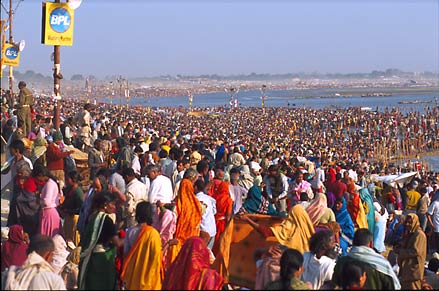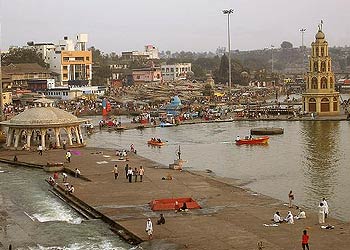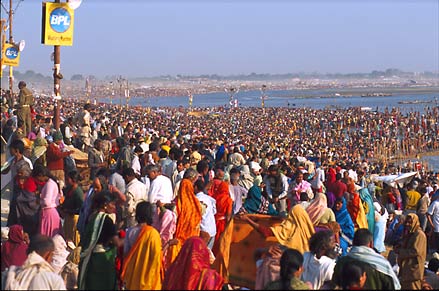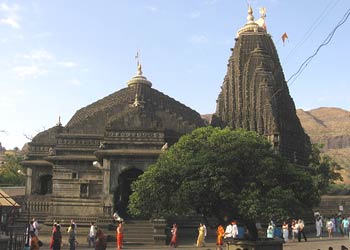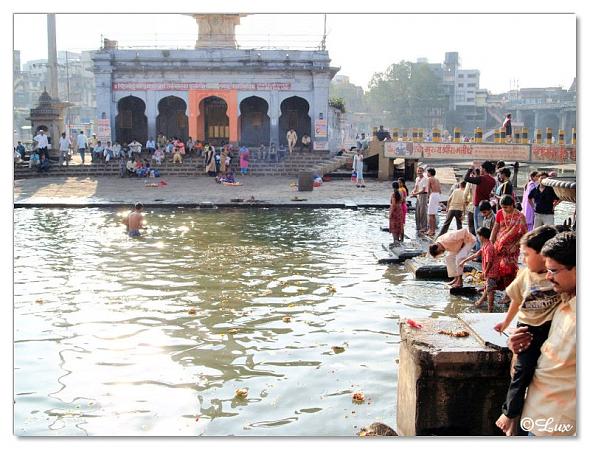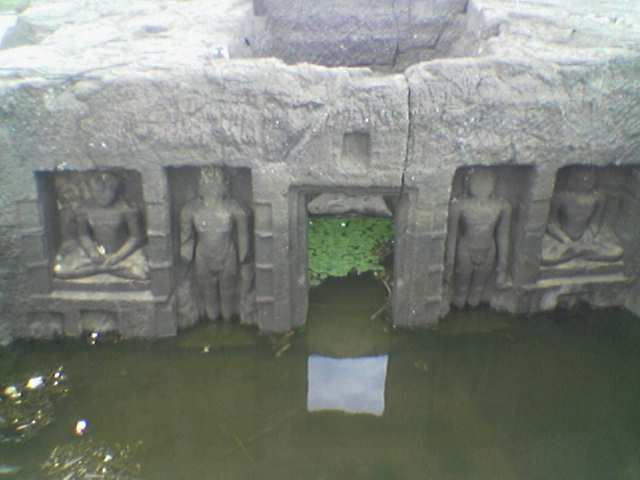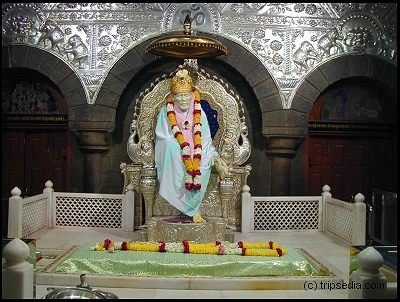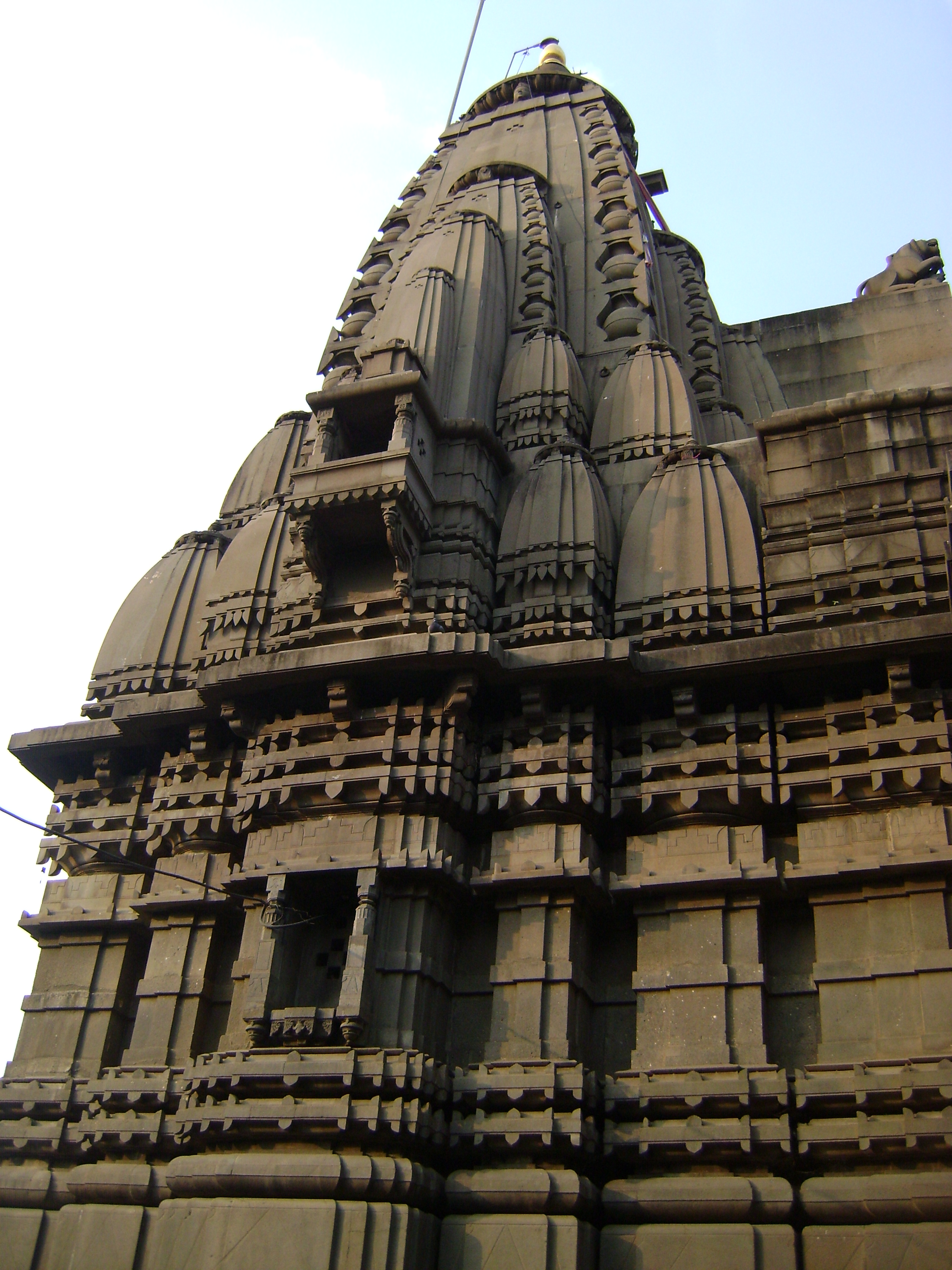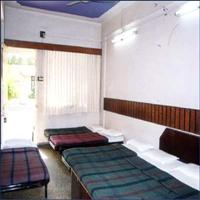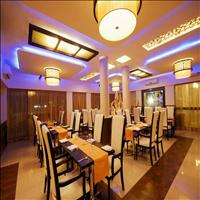Nashik
The City of Pilgrimage
General Information
Other Name: Nasik, District: Nashik, State: Maharashtra, India
Area: 259.13 Sq. Km.
Languages Spoken: Marathi, Hindi, English.
Long Distance Code: +91-253
Importance: Pilgrimage site
Best Time to Visit: October to March
Description
Nashik attracts thousands of pilgrims annually because of the sanctity of the Godavari River, which is called the Ganges of the south and also because of the legend that Ram, the hero of the Ramayana epic, had spent most of his banishment tenure here, with his wife Sita and his brother Lakshman. The Artillery school of Deolali, the MiG Aircraft Factory at Ozar and the internationally acclaimed grapes form Nashik have made the city popular.<br />The city, vibrant and active on the industrial, political, social and cultural fronts, has influenced the lives of many a great personalities. The River Godavari flows through the city. Temples and ghats on the banks of Godavari have made Nashik one of the holiest places for Hindus. All this territory was included in Ashok's mighty empire. From archaeological excavations it is found that the territory around Nashik was occupied in the early Stone Age. Its only real monuments are the rock-cut caves nearby Pandav Lena, these two-thousand-year-old cells dates back to the days when Nashik was the capital of the powerful Satavahana. It became very prosperous as it lay on the trade route to Broach. The city was named as Gulshanabad by the Mughals appreciating its rich natural wealth and renamed Nashik by the Marathas. Nashik played an important role in the freedom movement and after independence became the second largest district of Maharashtra.Location
Along the Godavari River 565m above sea level and about 185-km from Mumbai, is the important religious center of Nashik. Nashik has abundant forest wealth which is mostly on the west of the district. Jalgaon and Aurangabad districts lie to the east of Nashik, to its south is Ahmednagar, and Dhule district and a part of Gujarat lie in the North.
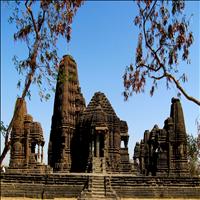 A beautiful temple built in the Hemadpanthi style of architecture, during the Adilshahi rule in Maharashtra. This style of architecture was developed by one of the ministers of Ahmednagar named Hemadri. He popularised this typical style of construction using locally available black stone and lime. This style became very popular but very few temples of this style can be seen today. The temple is dedicated to Lord Shiva.
A beautiful temple built in the Hemadpanthi style of architecture, during the Adilshahi rule in Maharashtra. This style of architecture was developed by one of the ministers of Ahmednagar named Hemadri. He popularised this typical style of construction using locally available black stone and lime. This style became very popular but very few temples of this style can be seen today. The temple is dedicated to Lord Shiva.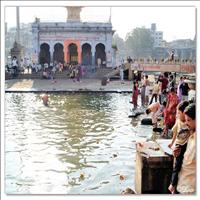 Ramkund is the spot where the river Godavari turns to right at an angle of 90 degrees and gains importance, as Lord Ram is said to have taken his daily bath here, during his stay at Nashik. Hundreds of pilgrims arrive here to take a holly dip at the Ramkund in the river Godavari.
Ramkund is the spot where the river Godavari turns to right at an angle of 90 degrees and gains importance, as Lord Ram is said to have taken his daily bath here, during his stay at Nashik. Hundreds of pilgrims arrive here to take a holly dip at the Ramkund in the river Godavari.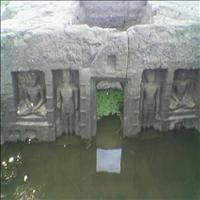 Pandavleni caves are a group of 24 Hinayana Buddhist Caves, dating from around the 1st century BC to the 2nd century AD, built by the Jain kings. These caves are situated about 8-km south of Nashik on a tableland atop the Trivashmi Hill, Cave 3 and cave 10 are viharas with some interesting sculptures. Cave 18 is a chaitya believed to date from the same time as the Karla Cave in Lonavala; it is well sculptured and its elaborate facade is particularly noteworthy.
Pandavleni caves are a group of 24 Hinayana Buddhist Caves, dating from around the 1st century BC to the 2nd century AD, built by the Jain kings. These caves are situated about 8-km south of Nashik on a tableland atop the Trivashmi Hill, Cave 3 and cave 10 are viharas with some interesting sculptures. Cave 18 is a chaitya believed to date from the same time as the Karla Cave in Lonavala; it is well sculptured and its elaborate facade is particularly noteworthy.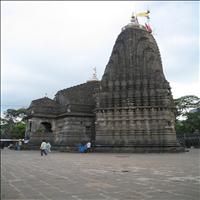 From a spring high on a steep hill above the village Trimbak, 33km west of Nasik, the source of the Godavari River dribbles into the Ganga-sagar bathing tank whose waters are reputed to wash away sins. From this tiny start the Godavari eventually flows down to the Bay of Bengal, clearly across India. Also in Trimbak is the Trimbakeshwar Temple, Trimbakeshwar is one of the twelve Jyotirlingas in India and the place is hardly 6 to 8 km from Nashik.
From a spring high on a steep hill above the village Trimbak, 33km west of Nasik, the source of the Godavari River dribbles into the Ganga-sagar bathing tank whose waters are reputed to wash away sins. From this tiny start the Godavari eventually flows down to the Bay of Bengal, clearly across India. Also in Trimbak is the Trimbakeshwar Temple, Trimbakeshwar is one of the twelve Jyotirlingas in India and the place is hardly 6 to 8 km from Nashik. The temple of Sapatashrungi Mata is on Saptashruga hill in the village Wani is very famous. It is about 52-Kms from Nashik City. The temple is atop a hill and there are 450 steps to climb. In April of every year, a major fair is held over here.
The temple of Sapatashrungi Mata is on Saptashruga hill in the village Wani is very famous. It is about 52-Kms from Nashik City. The temple is atop a hill and there are 450 steps to climb. In April of every year, a major fair is held over here.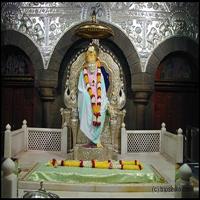 Shirdi is a very sacred and important place of pilgrimage in India. It is about 100 km drive from Nashik. Shirdi was a sleepy little village, tucked away in the interiors of Maharashtra and got famous because the sage Sai Baba. He was the mentor and prophet. Even today the last few surviving elders of the village vividly recall the miraculous wonders of the sage. He died in 1918. people from all the religion have faith in the saint and throng the place for his blessings.
Shirdi is a very sacred and important place of pilgrimage in India. It is about 100 km drive from Nashik. Shirdi was a sleepy little village, tucked away in the interiors of Maharashtra and got famous because the sage Sai Baba. He was the mentor and prophet. Even today the last few surviving elders of the village vividly recall the miraculous wonders of the sage. He died in 1918. people from all the religion have faith in the saint and throng the place for his blessings. Northern part of Nashik is known as Panchavati as River Godavari flows. There are five Banyan (Vat) trees and hence the area is called Panchavati. \r\n It is believed that Lord Shri Ram and Sita along with Lakshman stayed at Panchavati for some time. Infact it was here that Sita spotted the golden deer and was abducted by the demon king Ravan. People believe that she was abducted from the Sita Gumpha. This is a small cave underneath a banyan tree. One can enter the cave with the help of a narrow staircase. The cave has the idol of Shree Ram, Lakshman and Sita. Thus Panchavati gained lot of importance.\r\n
Northern part of Nashik is known as Panchavati as River Godavari flows. There are five Banyan (Vat) trees and hence the area is called Panchavati. \r\n It is believed that Lord Shri Ram and Sita along with Lakshman stayed at Panchavati for some time. Infact it was here that Sita spotted the golden deer and was abducted by the demon king Ravan. People believe that she was abducted from the Sita Gumpha. This is a small cave underneath a banyan tree. One can enter the cave with the help of a narrow staircase. The cave has the idol of Shree Ram, Lakshman and Sita. Thus Panchavati gained lot of importance.\r\nCulture and Pilgrimage of Maharashtra / PI-0363 (16 Days / 15 Nights)
Mumbai-Pune-Bhimashankar-Pune-Aurangabad-Grishneshwara-Aurangabad-Shirdi-Shanishinganapur-Shirdi-Nashik-Trimbakeshwar-Nashik-Mumbai
Nestled close to Arabian Sea, enjoy a holiday trip to Maharashtra, the third largest state of India. In addition to several cultural and modern attractions, the state is also dotted with many pilgrimage spots such as the Synagogue in Pune , Siddhivinayak Ganesha Temple in Mumbai and the holy city of Shirdi where people of all faiths come with joined hands. The state is cultural, modern as well as religious tourist destination for people of all faiths and religions.
Detailed Itinerary
Day 1 : Mumbai
Day 2 : Mumbai
Day 3 : Mumbai - Pune
Day 4 : Pune
Day 5 : Pune - Bhimashankar - Pune
Day 6 : Pune - Aurangabad
Day 7 : Aurangabad
Day 8 : Aurangabad
Day 9 : Aurangabad
Day 10 : Aurangabad - Grishneshwara - Aurangabad
Day 11 : Aurangabad - Shirdi
Day 12 : Shirdi - Shanishinganapur - Shirdi
Day 13 : Shirdi - Nashik
Day 14 : Nashik - Trimbakeshwar - Nashik
Day 15 : Nashik - Mumbai
Day 16 : Mumbai
Mumbai-Pune-Bhimashankar-Pune-Aurangabad-Grishneshwara-Aurangabad-Shirdi-Shanishinganapur-Shirdi-Nashik-Trimbakeshwar-Nashik-Mumbai
Nestled close to Arabian Sea, enjoy a holiday trip to Maharashtra, the third largest state of India. In addition to several cultural and modern attractions, the state is also dotted with many pilgrimage spots such as the Synagogue in Pune , Siddhivinayak Ganesha Temple in Mumbai and the holy city of Shirdi where people of all faiths come with joined hands. The state is cultural, modern as well as religious tourist destination for people of all faiths and religions.
Detailed Itinerary
Day 1 : Mumbai
Day 2 : Mumbai
Day 3 : Mumbai - Pune
Day 4 : Pune
Day 5 : Pune - Bhimashankar - Pune
Day 6 : Pune - Aurangabad
Day 7 : Aurangabad
Day 8 : Aurangabad
Day 9 : Aurangabad
Day 10 : Aurangabad - Grishneshwara - Aurangabad
Day 11 : Aurangabad - Shirdi
Day 12 : Shirdi - Shanishinganapur - Shirdi
Day 13 : Shirdi - Nashik
Day 14 : Nashik - Trimbakeshwar - Nashik
Day 15 : Nashik - Mumbai
Day 16 : Mumbai
The Deccan Odyssey / PI-054 (9 Days / 8 Nights)
Mumbai-Ratnagiri-Jaigadh-Ganapatipule-Ratnagiri-Sindhudurg-Tarkarli-Sawantwadi-Goa-Pune-Aurangabad-Ajanta Cave-Nashik-Mumbai
As the wind whispers through the halo of legends crowning the land of the mighty Marathas, a lone majestic whistle blows its salutation of honour as it gracefully traverses this land of fantasy. Welcome to the mesmerizing Maharashtra. Experience aboard the luxurious DECCAN ODYSSEY. A train journey adorned in luxury, the Deccan Odyssey transports its guests on an unforgettable sojourn of a land shining in legions grandeur - serene beaches, magnificent forts palaces, and experiencing heavenly tales etched in colossal rocks.Experience the finest and the best of train journeys of the world. The Deccan Odyssey is much more than a mere luxury train cruise. It''s a ''classical odyssey'' of time beyond the realms of the present. Welcome aboard!
Detailed Itinerary
Day 1 : Mumbai-Ratnagiri
Day 2 : Jaigadh-Ganapatipule-Ratnagiri
Day 3 : Sindhudurg-Tarkarli-Sawantwadi
Day 4 : Goa
Day 5 : Pune
Day 6 : Aurangabad
Day 7 : Ajanta Cave-Nashik
Day 8 : Mumbai
Day 9 : Mumbai
Mumbai-Ratnagiri-Jaigadh-Ganapatipule-Ratnagiri-Sindhudurg-Tarkarli-Sawantwadi-Goa-Pune-Aurangabad-Ajanta Cave-Nashik-Mumbai
As the wind whispers through the halo of legends crowning the land of the mighty Marathas, a lone majestic whistle blows its salutation of honour as it gracefully traverses this land of fantasy. Welcome to the mesmerizing Maharashtra. Experience aboard the luxurious DECCAN ODYSSEY. A train journey adorned in luxury, the Deccan Odyssey transports its guests on an unforgettable sojourn of a land shining in legions grandeur - serene beaches, magnificent forts palaces, and experiencing heavenly tales etched in colossal rocks.Experience the finest and the best of train journeys of the world. The Deccan Odyssey is much more than a mere luxury train cruise. It''s a ''classical odyssey'' of time beyond the realms of the present. Welcome aboard!
Detailed Itinerary
Day 1 : Mumbai-Ratnagiri
Day 2 : Jaigadh-Ganapatipule-Ratnagiri
Day 3 : Sindhudurg-Tarkarli-Sawantwadi
Day 4 : Goa
Day 5 : Pune
Day 6 : Aurangabad
Day 7 : Ajanta Cave-Nashik
Day 8 : Mumbai
Day 9 : Mumbai
Nashik, India Tours


